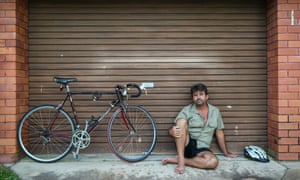Extract from The Guardian
For those committed to alleviating poverty, raising Newstart is the urgent priority, and the easiest immediate fix
Racheal
Persico hands around something called the Work Readiness Skills Map.
The young people at the table stare at the list of skills employers are
seeking. Reading. Writing. Digital literacy. Then the more abstract
ones. Flexibility. Problem solving. Planning. Persico is a coach and she
goes from teenager to teenager, encouraging them to identify which
areas they feel confident about and which need improvement.
It would be a confronting exercise for anyone, but these young Australians have extra challenges, even as they joke among themselves, sip on cans of Red Bull and ponder their future. One hopes to work with animals one day, another with computers, a third in retail.
Dylan Halpin, 18, wants to be a carpenter. “It needs to be physical,” he says. “I don’t want to be behind a desk.”
Halpin is on youth allowance, the unemployment benefit for those aged
16 to 21 who are looking for work. The government social security
provider, Centrelink, referred him to this Brotherhood of St Laurence
program in Frankston, south-east of Melbourne. It’s part of a $212m
federally funded program to give vulnerable young people intense support
to find a job.It would be a confronting exercise for anyone, but these young Australians have extra challenges, even as they joke among themselves, sip on cans of Red Bull and ponder their future. One hopes to work with animals one day, another with computers, a third in retail.
Dylan Halpin, 18, wants to be a carpenter. “It needs to be physical,” he says. “I don’t want to be behind a desk.”
For all the campaigning about the low rate of Newstart and youth allowance, and the evidence that the payments contribute to poverty, the complexity of disadvantage goes deeper. About 10% of Australians – or 2 million people – live in income poverty and the figure has barely budged for three decades. Most people move in and out of poverty as it is usually defined, but not all; about 3% of Australians – around 700,000 people – have lived with income poverty continuously for at least the last four years.
Unemployment is a key risk. More than a third of Newstart recipients stay on the payment for less than one year, usually escaping poverty when they get a job. But close to half remain on Newstart for more than two years, countering the argument that the payment is so low because it is meant as a short-term stopgap until a new job is found. The single basic rate of Newstart is $277.85 a week, which has not increased in real terms for a quarter of a century.
The risks bubble up at every stage of life. Many young Australians are studying, but, for those aged 15 to 24 who are in the labour force, the rate of unemployment is 11.7%, more than twice the general unemployment rate. That’s 259,100 young Australians.
In some regional areas, it’s closer to 25%.

“As soon as I dropped out of school, she was like, ‘You’re getting a job, where’s your job?’ She kept pushing me. As soon as I turned 18, she wasn’t getting any money for me, Centrelink cut her off. I went on Centrelink a year later nearly.”
Halpin’s extra vulnerability is that he left school before finishing year 10 – the evidence is that more than 60% of Australians who experience deep and persistent disadvantage leave school at year 11 or earlier. “I was OK at school I guess, I was always bad at attendance,” he says, citing an operation on his knee after a football injury that kept him from school for months.
“When you go and then you don’t go, you just get lost and you don’t know where you’re up to.” Since leaving school, he has completed a year 10 equivalent course at Tafe.
The teenagers in Frankston are uninterested in policy debates, more so in their own circumstances and future. Halpin is resistant to a “poor me” framing. He’s not that poor, he says. “I’m not starving and I have a decent pair of jeans on,” he says with a smile. Without a hint of self-pity, he adds: “Honestly, I don’t eat every day. That saves some money I guess. I don’t eat three meals a day.” He spends $20 a week on alcohol, “kind of bad”. And he walks everywhere.
What this program offers is intense one-on-one support, not the more formulaic assistance provided by the unemployment service provider, Jobactive. It might be building confidence, it might be as simple as a bus ticket to a job interview, or decent clothes. Halpin attends workshops like this one, and has a weekly meeting with a coach.
On the wall is a vision board, a visual reminder of the teenagers’ dreams. For more than one, a driver’s licence is the goal. Without a licence, getting work is hard. Halpin worries he won’t get an apprenticeship without a licence and he has no car or money for lessons. But he’ll overcome that somehow.
‘I’ve never worked anywhere more than 12 months’
At the other end of the country, Sterling Bellinger is at his local Centrelink office in Townsville. At 49, he’s decades on from Halpin, but there are similarities.“I’ve only got a year 10 education and I failed. I got a very limited achievement for all those subjects. I’m uneducated. I’ve got no trades or real qualifications. I’ve been on Newstart basically since I was 17, on and off.”
Over the phone, Bellinger comes across as philosophical, self-aware. His life hasn’t turned out the way he’d hoped, but he’s lived, loved (he has two children, aged 12 and 17 ) and learned about himself and others. “I’ve had some good experiences in my life,” he says. “I probably could have done a lot more had I more secure work I suppose, but I think it’s made me who I am today.”
Bellinger’s life reflects his early disadvantages and a changing labour market. He moved between several primary schools when he was young and got behind. His parents divorced, and he was raised by his single mother, a risk factor for child poverty.
Today, Townsville is struggling with an official unemployment of 8%, compared with a national average of 5%.

What’s happened in wealthier countries is that while highly educated people experience nearly full employment, there is structural underemployment for people with poor education. Low-skilled permanent jobs are declining, and casual and less secure work growing. That’s the world Bellinger navigates.
He gets work when he can. Today he’s at Centrelink reporting the three days’ work he did for a labour hire company the previous week, helping fit out a kitchen at the Lavarack army barracks. He’s worked since he was 13, inserting pamphlets at the Townsville Bulletin. He’s worked in the mines. He’s done labouring jobs, and worked for a biosecurity company.
“I’ve done a bit of everything,” he says. “With labour hire, they hire you for two weeks here, one month there, three days here. If you read the contracts, no further work is implied or guaranteed.
“I’ve never worked anywhere more than 12 months for the last 30 years.”
"Every job I applied for there were hundreds of people applying. It’s like winning a lottery."
His Newstart payment, with top-ups including rent assistance, is about $350 a week. Whenever he works, his payment is reduced. Under Jobactive rules, he used to be required to apply for 20 jobs a month to receive his payment, but there were not enough jobs in Townsville, so it’s come down to just two a month. His job plan is to look for work and to attend a monthly meeting.
“There aren’t full-time jobs,” he says. “They are just not there, they are all casual jobs.
“I used to just apply for any job. I applied for jobs as managers, stuff that I’m not qualified for, but the computer takes that I applied for that position. It just seemed like you’re going through the motions.”
Bellinger understands the system and plays by its rules. He says his Jobactive provider is respectful and tries to help him. He attends courses and has completed a work-for-the-dole program. His payment was suspended at one time – unfairly and for a minor thing, he says – so he’s scrupulous about fulfilling his obligations.
He is categorised in “stream c”, which means he faces the highest barriers to employment. That is due to his lack of education and skills, and also because he spent five months in prison a couple of years ago after an assault during a neighbourhood dispute. If employers ask him about it, he’ll tell them.

For now, life has a rhythm. Years ago Bellinger used to watch TV for 16 hours a day. Now he gets up at 7am, has breakfast, dresses well and takes public transport to his Jobactive provider’s office. He can’t afford the internet so he uses it there, looking for jobs, completing online courses. He does that almost every day.
But the week we speak, he has another appointment. He has a missing front tooth and has been saving for months for the $340 to have it fixed at a university dental school. He’s thrilled. He’s hoping to do another course in some kind of counselling so he can work with homeless people. “My options are limited and I’ll always be treated as such, so if I can climb my way up just one rung on the ladder, I’d feel good within myself that I’m helping others.”
‘I don’t even get interviews any more’
Those facing long-term poverty due to unemployment are not just the vulnerable young, nor the uneducated middle-aged. Increasingly, the long-term unemployed are mature people, many of whom have lost jobs after decades of full-time work. According to an Australian Council of Social Service (Acoss) analysis in 2018, almost half of recipients of Newstart for more than a year were over 45 years old.They are people like Wendy Morgan, now 57, who lost her laboratory technician’s job in 2012 when a global thermal insulation company shut down its Adelaide branch. She had worked there for six years, and, while her redundancy came as a shock, she thought she would have no trouble getting another job. That was seven years ago.

Once her savings ran out, Morgan couldn’t afford her private rental on Newstart. She says her electricity was cut off as she couldn’t pay the bill and she was homeless for a time. She now lives in social housing and she can breathe again – the rent is $160 a fortnight.
Morgan, who stood for the Greens at last year’s South Australian elections, now campaigns for the rights of the unemployed. She works as a private tutor for year 11 and 12 physics and chemistry students and does some cleaning jobs. It’s something, but doesn’t believe she will get full-time work again.
“I’ve given up on that really. I do still try, but I don’t even get interviews any more. I don’t even get replies.”
Acoss and other welfare groups have run a well-publicised campaign to raise the Newstart rate by $75 a week, at a cost of $3.3bn. It would be the single biggest measure to ease poverty in Australia, and to help people in their search for work. The Liberal party has no plans to increase Newstart in real terms, and is proposing random drug tests for recipients. Labor has acknowledged the payment is too low, but won’t commit to an increase until a review after the election. The Greens pledge a $75 a week rise for both Newstart and youth allowance.
For those committed to alleviating poverty, Newstart is the urgent priority, but only the first one. The causes of persistent poverty are complicated and the solutions long-term.
They are about people like Dylan Halpin, shifting in his seat as he admits he is taking little interest in the election campaign. He doubts if politicians care much about people like him. “I’m just one guy, they wouldn’t pay attention to me I guess,” he says.
But he has plans. Big plans. “In five years’ time, I want to have a bit of money saved up,” he says. “Around that time, you want to get a house, definitely a licence, car, a steady job.
“I want a job. A job is always the No 1 priority.”
Reporting in this series is supported by VivCourt through the Guardian Civic Journalism Trust

No comments:
Post a Comment